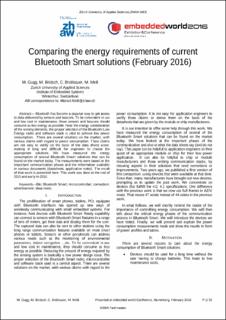Please use this identifier to cite or link to this item:
https://doi.org/10.21256/zhaw-1999Full metadata record
| DC Field | Value | Language |
|---|---|---|
| dc.contributor.author | Gugg, Mathias | - |
| dc.contributor.author | Brütsch, Manuel | - |
| dc.contributor.author | Brülisauer, Cornel | - |
| dc.contributor.author | Meli, Marcel | - |
| dc.date.accessioned | 2018-06-18T09:34:36Z | - |
| dc.date.available | 2018-06-18T09:34:36Z | - |
| dc.date.issued | 2016 | - |
| dc.identifier.uri | https://digitalcollection.zhaw.ch/handle/11475/7038 | - |
| dc.description.abstract | Bluetooth has become a popular way to get access to data delivered by sensors and beacons. To be convenient in use and low cost in maintenance, those sensors and beacons should consume as less energy as possible. Near the energy consideration of the sensing elements, the proper selection of the Bluetooth Low Energy radio and software stack is vital to achieve low power consumption. There are several solutions on the market, with various claims with regard to power consumption. These claims are not easy to verify on the basis of the data sheets alone, making it long and difficult for engineers to choose the appropriate solutions. We have measured the energy consumption of several Bluetooth Smart solutions that can be found on the market today. The measurements were based on the important communication phases and the information available in various documents (datasheets, application notes). The result of that work is presented here. This work was done at the end of 2015 and early in 2016. | de_CH |
| dc.language.iso | en | de_CH |
| dc.publisher | WEKA Fachmedien | de_CH |
| dc.rights | Licence according to publishing contract | de_CH |
| dc.subject | Sleep | de_CH |
| dc.subject | Bluetooth smart | de_CH |
| dc.subject | Wireless | de_CH |
| dc.subject | Low power | de_CH |
| dc.subject.ddc | 004: Informatik | de_CH |
| dc.subject.ddc | 621.3: Elektro-, Kommunikations-, Steuerungs- und Regelungstechnik | de_CH |
| dc.title | Comparing the energy requirements of current bluetooth smart solutions (February 2016) | de_CH |
| dc.type | Konferenz: Paper | de_CH |
| dcterms.type | Text | de_CH |
| zhaw.departement | School of Engineering | de_CH |
| zhaw.organisationalunit | Institute of Embedded Systems (InES) | de_CH |
| dc.identifier.doi | 10.21256/zhaw-1999 | - |
| zhaw.conference.details | Embedded World Conference, Nuremberg, Germany, 23-25 February 2016 | de_CH |
| zhaw.funding.eu | No | de_CH |
| zhaw.originated.zhaw | Yes | de_CH |
| zhaw.publication.status | publishedVersion | de_CH |
| zhaw.publication.review | Not specified | de_CH |
| Appears in collections: | Publikationen School of Engineering | |
Files in This Item:
| File | Description | Size | Format | |
|---|---|---|---|---|
| EW2016 meli-paper-comparing ble transceivers_V2.pdf | 2.91 MB | Adobe PDF |  View/Open |
Show simple item record
Gugg, M., Brütsch, M., Brülisauer, C., & Meli, M. (2016). Comparing the energy requirements of current bluetooth smart solutions (February 2016). Embedded World Conference, Nuremberg, Germany, 23-25 February 2016. https://doi.org/10.21256/zhaw-1999
Gugg, M. et al. (2016) ‘Comparing the energy requirements of current bluetooth smart solutions (February 2016)’, in Embedded World Conference, Nuremberg, Germany, 23-25 February 2016. WEKA Fachmedien. Available at: https://doi.org/10.21256/zhaw-1999.
M. Gugg, M. Brütsch, C. Brülisauer, and M. Meli, “Comparing the energy requirements of current bluetooth smart solutions (February 2016),” in Embedded World Conference, Nuremberg, Germany, 23-25 February 2016, 2016. doi: 10.21256/zhaw-1999.
GUGG, Mathias, Manuel BRÜTSCH, Cornel BRÜLISAUER und Marcel MELI, 2016. Comparing the energy requirements of current bluetooth smart solutions (February 2016). In: Embedded World Conference, Nuremberg, Germany, 23-25 February 2016. Conference paper. WEKA Fachmedien. 2016
Gugg, Mathias, Manuel Brütsch, Cornel Brülisauer, and Marcel Meli. 2016. “Comparing the Energy Requirements of Current Bluetooth Smart Solutions (February 2016).” Conference paper. In Embedded World Conference, Nuremberg, Germany, 23-25 February 2016. WEKA Fachmedien. https://doi.org/10.21256/zhaw-1999.
Gugg, Mathias, et al. “Comparing the Energy Requirements of Current Bluetooth Smart Solutions (February 2016).” Embedded World Conference, Nuremberg, Germany, 23-25 February 2016, WEKA Fachmedien, 2016, https://doi.org/10.21256/zhaw-1999.
Items in DSpace are protected by copyright, with all rights reserved, unless otherwise indicated.